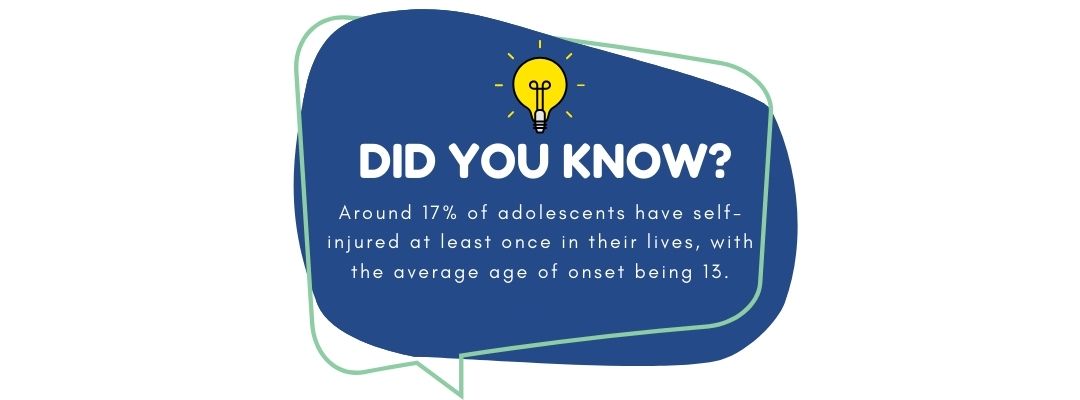Why Do People Cut Themselves? Understanding the Causes and Coping Mechanisms
Why do people cut themselves? Many individuals struggle with the urge to cut themselves as a way to cope with emotional pain. People often engage in self-injury as a means to express feelings that may be too overwhelming to articulate otherwise. While this behavior may provide temporary relief, it can also lead to more serious mental health issues.
Understanding why someone self-harms can illuminate the deeper emotional struggles they face. Factors such as trauma, depression, or anxiety often contribute to this behavior. Providing support and encouraging healthier coping strategies are essential steps for those who seek help.
Key Takeaways
- Self-injury can be a sign of underlying emotional distress.
- Understanding risk factors can help in prevention efforts.
- Supportive connections are crucial for recovery and coping.

Source: Healtyplace
Understanding Self-Injury: Why Do People Cut Themselves?
Self-injury is an act where individuals intentionally harm their own bodies. This behavior often stems from emotional distress and can affect people across various age groups. Understanding the definition and prevalence of self-injury, along with the psychological mechanisms behind it, is essential for recognizing its seriousness.
Definition and Prevalence
Self-injury refers to the intentional destruction of body tissue without suicidal intent. Common forms include cutting, burning, and scratching. Many individuals may self-injure as a way to cope with emotional pain or intense feelings.
Studies show that self-injury is prevalent among adolescents and young adults. Estimates suggest that around 1 in 5 teenagers engage in self-harm. While it often manifests in visible areas like arms and legs, it can occur anywhere on the body.
Awareness of self-injury is vital for prevention and intervention efforts. Recognizing this behavior in someone can be the first step toward getting them the help they need.
Psychological Mechanisms
The reasons behind self-injury can vary widely but often connect to underlying emotional struggles. Individuals might use self-harm as a coping mechanism to release pent-up emotions. It may provide temporary relief from sadness, anger, or anxiety.
The act can create a sense of control when other areas in life feel chaotic. It might also serve as a way to express feelings when individuals lack the words to do so.
Some may engage in self-injury due to feelings of numbness or disconnect. The physical pain can serve as a reminder that they are alive. Understanding these psychological factors is crucial for developing effective treatment strategies.
Risk Factors
Various factors can increase the likelihood of self-harm behaviors. Understanding these personal and environmental influences is crucial in recognizing at-risk individuals.
Personal Factors
Certain personal traits can heighten the risk of self-injury. Individuals with a history of mental health issues, such as depression or anxiety, are more likely to engage in self-harm. This is often due to difficulties in managing emotions.
Moreover, those who have experienced trauma, such as abuse or neglect, may resort to self-injury as a coping mechanism. Feelings of low self-esteem and isolation can also play significant roles.
Age is another factor; many individuals who self-harm are adolescents or young adults, navigating the emotional challenges of growing up. Similarly, gender shows trends, with females generally reporting higher rates of self-injury than males.
Environmental Influences
Environmental factors can greatly impact self-harm behaviors. A supportive or stable home environment can help reduce the risk. Contrarily, individuals living in chaotic or abusive settings may struggle more with emotional distress.
Peer influences are also significant. Friends or acquaintances who engage in self-harm can lead to an increase in similar behaviors. The desire to fit in or alleviate personal pain often drives this.
Additionally, exposure to negative life events, like bullying or discrimination, can intensify feelings of worthlessness. Drug or alcohol misuse in one’s environment often coincides with self-harming behaviors, creating a cycle of harm and emotional struggle.
Effects of Self-Harm
Self-harm can lead to serious physical and emotional consequences. Understanding these effects is important for recognizing the signs and helping those in need.
Physical Consequences
Self-harm can cause a range of physical issues. The most common form involves cutting, which can result in:
- Scarring: Cuts may heal, but they often leave permanent scars.
- Infections: Open wounds can easily become infected if not properly cared for.
- Nerve Damage: Severe or repeated injuries can harm nerves, leading to loss of sensation in affected areas.
- Blood Loss: In some cases, self-harm can lead to significant bleeding, which may require medical attention.
These physical effects can affect an individual’s health and quality of life. Furthermore, they may lead to feelings of shame and embarrassment, making recovery more difficult.
Emotional Impact
The emotional effects of self-harm can be profound. Many individuals use self-harm as a way to cope with intense feelings. This can lead to:
- Guilt and Shame: After a self-harm episode, feelings of guilt may surface, contributing to a negative self-image.
- Increased Emotional Pain: The relief gained from self-harm is often temporary. This can result in a cycle where emotional pain increases over time.
- Isolation: Individuals may withdraw from friends and family, fearing judgment or misunderstanding. This can further intensify feelings of loneliness.
- Higher Risk of Mental Health Issues: Those who engage in self-harm are at greater risk for anxiety, depression, and other mental health disorders.
Recognizing these emotional impacts is crucial for providing support and resources to affected individuals.
Coping and Support Strategies
Effective coping and support strategies can make a significant difference for individuals who engage in self-harming behaviors. Using professional treatment options and self-help resources can help reduce the urge to self-harm and promote healing.
Professional Treatment Options
Therapists play a crucial role in helping individuals overcome self-harm. They offer various therapies tailored to specific needs. Cognitive Behavioral Therapy (CBT) is common. It helps individuals identify and change negative thought patterns.
Dialectical Behavior Therapy (DBT) is another effective approach. It focuses on building skills for emotional regulation and distress tolerance.
Medication may also be prescribed to address underlying issues like depression or anxiety. A healthcare provider can suggest the best treatment based on the individual’s situation. Seeking help from a trained professional fosters a supportive environment for recovery.
Self-Help and Community Support
Self-help strategies can empower individuals to manage their feelings. Keeping a journal allows them to express emotions and track triggers. Practicing mindfulness techniques, such as meditation or deep breathing, can also be beneficial.
Community support is vital. Joining a support group connects individuals with others who understand their struggles. In these groups, people can share experiences and coping strategies.
Building a strong support network is important. Friends and family can offer encouragement and understanding. Engaging in healthy activities, like exercise or art, can provide positive outlets for emotions.
Reaching out for help shows strength and willingness to improve.
Prevention and Outreach
Preventing self-harm requires effective strategies that include educational programs and public awareness campaigns. These efforts aim to inform, support, and reach those at risk.
Educational Programs
Educational programs play a crucial role in prevention. These initiatives can be implemented in schools and community centers, targeting students and parents. They cover the signs of self-harm, its triggers, and ways to seek help.
Programs should include workshops, discussions, and resource materials. They can introduce coping strategies to manage emotional distress. Engaging mental health professionals to lead these sessions is beneficial.
Interactive components can foster open dialogue and encourage participants to ask questions. Empowering youth with knowledge helps reduce stigma around self-harm. Schools that adopt these programs can create a supportive environment for students in need.
Public Awareness Campaigns
Public awareness campaigns spread information about self-harm. They aim to reach a broader audience through social media, posters, and community events. These campaigns can highlight the importance of recognizing signs of self-injury and promoting mental health resources.
Effective campaigns use clear, factual messaging. They can feature personal stories to create empathy and connection. Utilizing relatable, positive imagery can help to normalize seeking help.
Collaborating with celebrities or influencers can increase visibility and engagement. Promoting hotlines and counseling services is crucial. Public awareness campaigns empower communities to provide support and encourage individuals to reach out for help.
Frequently Asked Questions
This section addresses common queries about self-harm behaviors and how to support individuals who may be affected. The information provided can help better understand the motivations behind self-injury and ways to assist those in need.
What are the underlying reasons for self-harm behaviors?
People engage in self-harm for various reasons. Some may do it to cope with emotional pain or distress. Others might use it as a way to express feelings that are hard to communicate.
How can you support someone you suspect may be harming themselves?
Supporting someone who may self-harm involves listening without judgment. It is important to create a safe space where they feel comfortable to talk. Encouraging them to seek professional help is also vital.
What are effective coping strategies to replace self-injurious habits?
Coping strategies can include engaging in creative outlets like art or music. Physical exercise or mindfulness practices, such as meditation, can also help manage emotions without the need for self-harm. Journaling thoughts and feelings is another useful approach.
What signs should be looked for to identify self-harm in individuals?
Signs of self-harm can include unexplained injuries or frequent wearing of long sleeves. Changes in mood, social withdrawal, and sudden shifts in behavior may also indicate self-injury. It is crucial to remain observant and sensitive to these changes.
How does one approach a conversation with a person who might be self-harming?
Approaching someone about self-harm should be done delicately. It is best to express concern while ensuring the person feels supported. Asking open-ended questions can encourage them to share their feelings, making the conversation more productive.
What treatments are available for individuals who self-harm?
Treatments for self-harm often include therapy, such as cognitive-behavioral therapy (CBT). This approach helps address underlying issues. Medication may also be prescribed to manage related mental health conditions, depending on individual needs.
Conclusion: Why Do People Cut Themselves?
Self-injury, particularly cutting, is a complex and deeply personal behavior often rooted in emotional distress. While it can provide temporary relief for some, the long-term physical and emotional consequences underscore the importance of addressing this behavior through understanding, support, and professional intervention. By raising awareness, fostering open conversations, and promoting effective coping strategies, we can create a more compassionate environment for individuals struggling with self-harm. Recovery is possible with the right resources and a network of care, reminding us that no one has to face their challenges alone.
You’re not alone, and help is always within reach. Contact us today at (774) 619-7750 and take control over your mental health.




